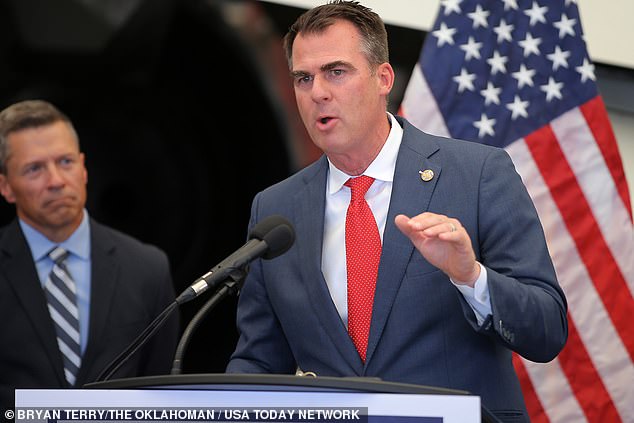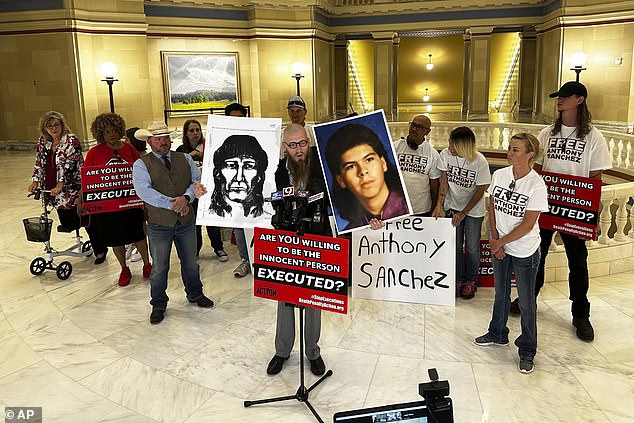Oklahoma death row inmate Anthony Sanchez, 44, executed for the 1996 rape and murder of a ballerina, Juli Basken, and maintained his innocence
Anthony Sanchez, 44, a death row inmate from Oklahoma, was executed at 10:19 a.m. Thursday for the rape and murder of a 21-year-old ballerina by lethal injection.
Sanchez received a series of three injections at the Oklahoma Department of Corrections, noting the victim’s family was not present.
The 44-year-old was sentenced to death after being convicted of the heinous crime against University of Oklahoma student Juli Basken, whom he kidnapped, sexually assaulted, tied up and shot in the head at Lake Stanley Draper.
His last meal consisted of chicken breast, fried okra, mashed potatoes, apple pie and ice cream, hot roll, sweet iced tea, telling KFOR on Tuesday: “I probably won’t be able to eat it, to tell you the truth.”
Despite a bullet, DNA evidence, a footprint and a sketch of the suspect that convinced a jury of his guilt, Sanchez maintained his innocence until execution but did not ask for leniency, claiming there was “little hope.”
While strapped to the gurney, Sanchez’s last words were, “I am innocent. I didn’t kill anyone.’
Some reports said he added that his lawyers were “the worst lawyers in the state of Oklahoma” and that he “feels sorry to whoever has them as lawyers.”
Anthony Sanchez, 44, a death row inmate from Oklahoma, was executed by lethal injection at 10:19 a.m. in 1996 for the rape and murder of a 21-year-old ballerina
Speaking to KFOR earlier this week, Sánchez said: “If this is what makes the Busken’s happy and allows them to move on, then I’m happy for them. But I’m innocent. I did not kill their daughter,” he added.
Sánchez also told the newspaper that he did not want any of his family to witness the execution.
“No one wants their son executed and that’s why I don’t want anyone here.”
The case remained unsolved for years until DNA from the crime scene was matched to Sanchez, who was serving prison time for burglary.
Although he insisted that he had nothing to do with Busken’s murder, he took over the case unusual step choosing not to file a clemency petition with the state Pardon and Parole Board, which many considered it the last chance to spare his life.
Shortly before he was put to death, the U.S. Supreme Court rejected a request for a stay of execution filed by his new attorney, Eric Allen, of Columbus, Ohio.

Juli Busken (pictured), a recent dance graduate from the University of Oklahoma, was found kidnapped from her apartment, raped and murdered in Oklahoma City in 1996. She was shot in the back of the head with a .22-caliber firearm, according to court records. documents
Allen had said he needed more time to review the case’s evidence.
Busken, a Benton, ArkansasNative had just completed her last semester of college when she was kidnapped from the parking lot of her Norman apartment complex on December 20, 1996.
Busken had performed as a ballerina in several dance performances during her tenure at OU, and she was commemorated on campus with a dance scholarship in her name at the College of Fine Arts.
Years later, Sanchez was serving a prison sentence for a burglary conviction when DNA from semen found on Busken’s clothing at the crime scene was linked to him. He was convicted and sentenced to death in 2006.
Sánchez has long maintained his innocence and did so again earlier this year from death row in a phone call to the Associated Press. “That’s made-up DNA,” Sánchez said. ‘That’s fake DNA. That’s not my DNA. I’ve been saying that since day one.’
He told the AP that he declined to ask for clemency because even if the five-member Pardon and Parole Board takes the rare step of recommending it, Gov. Kevin Stitt is unlikely to grant it.
“I have sat in my cell and watched as prisoner after prisoner after prisoner was pardoned and denied pardon,” Sánchez said. “Anyway, the prisoners aren’t doing well.”
Oklahoma Attorney General Gentner Drummond claimed that the DNA evidence unequivocally linked Sánchez to Busken’s murder.
A sample of Anthony Sanchez’s DNA “was identical to the profiles developed from semen on Busken’s panties and leotard,” Drummond wrote last month in a letter to a state representative who had inquired about Sanchez’s conviction.

Gov. Kevin Stitt (pictured June 14, 2023) has granted clemency only once. Sanchez claimed there is “little hope” that the state’s Republican governor, Kevin Stitt, would spare his life

Supporters of Oklahoma death row inmate Anthony Sanchez proclaim his innocence during a news conference at the Oklahoma Capitol in Oklahoma City, May 25, 2023
Drummond added that there was no evidence that either profile was mixed with DNA from another individual and that the odds of randomly selecting an individual with the same genetic profile were 1 in 94 trillion among Southwestern Hispanic people.
“There is no doubt that Anthony Sanchez is a brutal rapist and murderer who deserves the state’s harshest sentence,” Drummond said in a recent statement.
A private investigator hired by an anti-death penalty group claimed that the DNA evidence may have been contaminated and that an inexperienced lab technician had misreported the strength of the evidence to a jury.
Former Cleveland County District Attorney Tim Kuykendall, who was the county’s top prosecutor when Sanchez was tried, has said that while the DNA evidence was the most compelling at trial, there was other evidence linking Sanchez to the murder, including ballistic evidence and a shoe print. found at the crime scene.
“I know from spending a lot of time on that case that there is not a single piece of evidence that pointed to anyone other than Anthony Sanchez,” Kuykendall said recently.
“It doesn’t matter to me whether a hundred people or a thousand people confess that they murdered Juli Busken.”
Oklahoma resumed carrying out the death penalty in 2021, ending a six-year moratorium due to concerns over execution methods.
The state had one of the busiest death chambers in the country until problems arose in 2014 and 2015.
Richard Glossip was just hours away from execution in September 2015 when prison officials realized they had been given the wrong deadly drug.
It was later learned that the same wrong drug had been used to execute a prisoner in January 2015.
